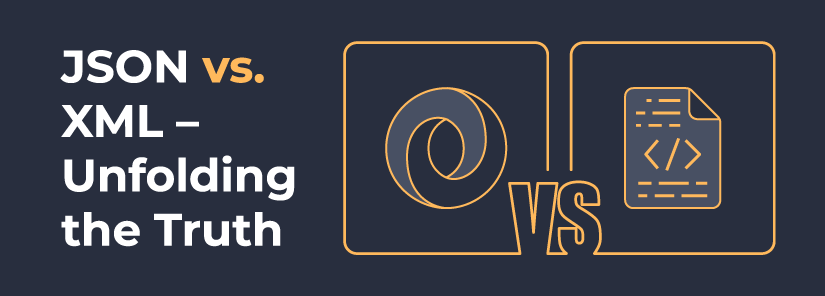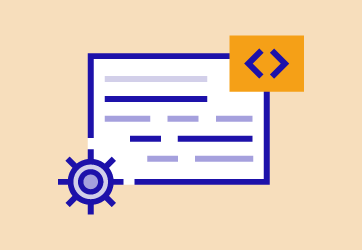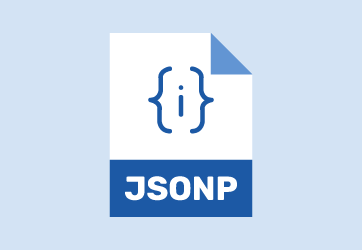JSON vs. XML – Unfolding the Truth


In the late 1990s, XML got a huge buzz around the web programmers, but since the last few years, JSON has created a buzz among web developers. It happened because, in the past few years, we have witnessed the mushrooming of JavaScript frameworks. As Ajax got into the realm of web development, now developers are finding out ways that can enhance the workability of user-side programming. By delivering web application infused with more dynamic outlooks. There has been always remained a heated debate among the programming community about the reliability and functionality of XML and JSON. The intensity of debate depicts that since the arrival of JSON, in a short time, it has beaten the hell out of XML. No doubt JSON has got strong footprints among the web community. It is shaking the traditional foundations of XML. And people have started to switch from JSON to XML. In this blog, we have discussed the reliability, and the working capacity of both the formats and have put forward strong arguments that JSON is better than XML.
What is JSON?
JSON stands for JavaScript Object Notation; it is the lightweight format, which helps transport data from server end to user end and vice versa. The format is self-describing and quite easy to comprehend. Along with that, the JSON format is syntactically identical to that of the objects created in the JavaScript framework. Therefore, the JSON data could be easily converted into JavaScript Objects. The format is written similar to that of JavaScript, and it bases itself upon name/value and pairs. The format works with a wide range of diverse applications, most importantly when there’s a need to communicate with the server. The format is independent and doesn’t rely on any other programming language, but it is derived from JavaScript.
Features of JSON
As discussed previously, JSON is an object-based format and has a standard structure, which makes it easy for the developers to comprehend. The format has the potential to work with all the programming languages. It works efficiently and parses the data superlatively. Let’s get to know about the features of JSON.
- Lightweight
When you are working with AJAX, it requires loading the data swiftly and asynchronously without the page to reload. Therefore, JSON is suitable in this process to load data quickly because it is lightweight.
- Scalable
Since the format is independent and doesn’t rely on any other programming language, so it is suitable to work with any web framework. For example, if you are looking to update your website by changing the programming language, the JSON format would work efficiently because the structure of the format for all languages is the same.
- Easy to Read and Write
The JSON format is easy to read and write. The developers find it easy to comprehend the structure. In comparison to XML, which is quite difficult to understand, the JSON format lets the web developers solve the bugs efficiently.
Pros of JSON
The JavaScript Object Notation is attracting a considerable chunk of web developers. The format is lightweight in comparison to other open data interchange options. However, it is not the only reason you should be using JSON for your API integrations. You need to consider the following pros of the format.
- Less Verbose
The JavaScript Object Notation has a compact style when it is compared to XML. Therefore, the readability of this format is far more than other data interchange mediums. Along with that, the lightweight feature of the format makes it more suitable for working with APIs, especially when dealing with complex systems.
- Synchronization Between Data and Structure
The format utilizes a map data structure instead of the tree format that is used in XML. There are situations where the value/pair develop a limited scope. However, the data model is easy to understand and predictable as well.
- Alignment in Code Objects
The code objects and JSON objects match with each other. It is of great benefit when you need to create domain objects in dynamic languages.
- Fast Data Parsing
The parsing time of XML data is quite lengthy. The reason for slow parsing is DOM manipulation libraries; it requires additional memory for handling large XML files. Whereas JSON utilizes less overall data, and it reduces the cost and increases parsing speed.
Cons of JSON
As discussed previously, JSON is a simple object serialization approach, and it bases itself on JavaScript object initializer syntax. The format is highly beneficial for the developers due to its certain features. However, there are disadvantages of the format that needs to be listed down for a better understanding.
- Lack of Standard Schema
Initially, JSON was developed by a web developer who was frustrated by the limitations of the web browser. Therefore, it lacks the same standard that has emerged for the XML over the years.
- Lack of Robust Data Structure
In JSON, you cannot add any tags, comments, or attributes. It limits the ability to annotate the data structure, and useful metadata isn’t added.
- JSON Doesn’t Support Base Types Like XML
The JSON format isn’t compatible with base types like XML. The XML can utilize different schema constructs for building up new information sets, while JSON lacks those features.
JSON Code
{
“books”:
[
{
“id”:”03″,
“language”:”JSON”
},
{
“id”:”05″,
“language”:”C++”
},
]
}
What is XML?
XML stands for Extensible Markup Language. It is used for the transportation of data from the server to the user side and vice versa. It is commonly used for the distribution of data. Therefore, web developers are in need of this format for transmitting the data. The format is human and machine-readable. The design emphasizes generality, accessibility, and usability. XML is an open standard format, and anyone can utilize it for connecting the server with the user-end side.
Features of XML
XML is said to be a classical alternative to JSON. Since the 1990s, the format is used widely and popular among web developers. It is due to the fact, most of the servers are still connected with XML. Let’s get to know about the features of XML.
- The format is good for handling atypical and complex data.
- The data is explained in a markup language.
- The format is friendly with humans and computers.
- It handles data in tree format.
Pros of XML
The format that is used to exchange information offers plenty of benefits. It handles the data with an RDB structure. It is quite good for managing complex data formations. It allows the description of data in text format, which makes it easy for the web developer to configure and understand the strings that are transmitting the data.
- Machine and Human-Friendly Format
Commonly data is stored and transmitted in CSV format. The programs also understand the data that is stored in CSV format. However, it appears to be continuous strings of data, but deep down, it is quite friendly for the machines to learn. The XML format uses the same way for transporting the data, which makes it human and machine friendly.
- Long-Term Data Storage
The XML format also allows storage of data for the long term. The data in XML is in text format and does not rely on any other application for making it transmissible. The data can be stored for a long period of time, and it could be specified from the developer’s end.
- XML’s Compatibility with Java
The format is completely compatible with the Java programming language. It is also portable, as any program that is able to process XML doesn’t need any other supplementary application to execute the process.
Cons of XML
There’s no doubt that XML is an efficient way of transmitting data, and over the years, it has developed itself ferociously. There are several disadvantages of this format. Let’s have a look at the cons of XML.
- Verbosity in XML
No one can deny the fact that XML is quite redundant to write. If you are coding a program or application from scratch in XML, you will have to put closing and ending tags to make the code workable. There are XML editors for this purpose to fix the errors, but we still have to look into it for better-performing functionality.
- Less Readability
In comparison to JSON, there’s less readability in XML. The JSON format is more suitable for this purpose as it is human-friendly and is written in plain text; there’s also no tree structure in it.
- Slow Data Parsing
The XML format is also quite slow in processing and parsing the data. It makes the format slow, while on the other hand, JSON is fast in parsing the data.
XML Code
<?xml version=”1.0″ encoding=”UTF-8″ ?>
<root>
<books>
<id>03</id>
<language>JSON</language>
</books>
<books>
<id>05</id>
<language>C++</language>
</books>
<books>
<id>09</id>
<language>PHP</language>
</books>
</root>
The Verbosity of XML
It is an undeniable fact, even the proponents of XML would agree that it is redundant to write. In case you are coding from scratch, you will have to focus on starting and closing tags keenly. Many XML programmers would argue that editor is always there to help out in such situations. But still, you will have to revisit again and again every single line of code to cross-check whether you have added the tags or not. Because if your code misses a single tag, it would become a bug and finding out such minor error is the most laborious task.
Whereas JSON is less verbose, and amazingly, it is lightweight, which makes it easy to transmit the data from the web application to the server and vice versa.
Lack of Semantics in XML
XML lacks in semantics, the syntax of this format is meaningless and is not able to even correlate with the data or content, the abstract data model of this format uplifts itself from the data and configure the content by its own element attributes. XML on its own define the meaning of data in the elements, which makes it not a readable format for human beings. It is basically Meta-language and free from semantic. On the other hand, JSON is based on semantics, which makes it easy for the human to interpret the data and for the machines to parse the information.
Conclusion
In the last analysis, developers prefer JSON over XML. Because of the reasons mentioned above. And for that reason, the former has gained strong footprints over the web. And most of the people are switching their sites from XML to JSON. It is recommended by tech experts to use JSON because it will enhance the user-interaction with your web application. And you will be able to deliver a user-friendly experience to your users.
If you are working with JSON then jsononline.net is the perfect place where you can get a perfect coding environment. Here you can get all the tool that can be needed while working with JSON.
October 21, 2021

October 13, 2021




Leave a Reply